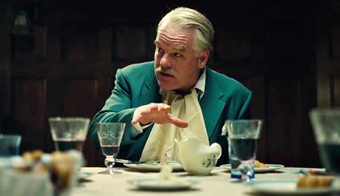
The Last Shape Shifter
By R. Alan Clanton | published Sunday, February 2, 2014 |
Thursday Review editor
Philip Seymour Hoffman, the actor whose chameleon attributes enabled him to so successfully morph into the characters he portrayed that we often forgot he was acting, was found dead early Sunday, February 2 in his Greenwich Village apartment. He was 46 years old.
Though not a household name in the sense that he occupied headlines the way Alec Baldwin or Sean Penn might, and though not chiseled with the sort of looks that brought him the brand of adoration movie fans might lavish upon leading men like Brad Pitt, Daniel Craig, Will Smith, Matt Damon or Orlando Bloom, Hoffman was instead what one would call an actor’s actor.
Philip Seymour Hoffman was a rare quantity—which is to say he was the kind of actor who floats across the film radar screen maybe only a handful of times each generation.
Like John Cazale (Dog Day Afternoon; The Godfather Part II) decades before him, Hoffman was unafraid to tackle the parts which required vulnerability, weakness, fear, self-doubt, even, at times, self-loathing. And in an age in which the Hollywood movie-making formula requires cocky self-assurance and bravado from its leading male roles (how many times has Tom Cruise basically played the role of Tom Cruise?) this meant that Hoffman was a true rarity, someone willing convert the looks and the tone and the voice that one might loosely define as non-traditional into mainstream power. He demanded little of the camera.
Conversely, his skill was such that he could essentially reverse the dynamic, as he did with uncanny power in The Master, a film in which he plays the self-assured, charismatic Lancaster Dodd (an analog to the real-life L. Ron Hubbard if there ever was one in modern cinema), the leader of a fledgling quasi-religious self-help cult which specializes in “processing” its members to free them of collective memories and billions of years of accumulated pain and fear. Hoffman plays opposite Joaquin Phoenix, who takes on the manic role of the dysfunctional Freddie Quell, a troubled, bipolar alcoholic with heavy baggage. The complex waltz between the two characters is one of the most chilling—and compelling—ever forged in recent movies (a testament not only to Hoffman’s skill, but also to director Paul Thomas Anderson).
Anderson, a visual perfectionist for whom it can be said shares the cinematic DNA of Stanley Kubrick and, more recently, Terrence Malick, had worked with Hoffman before, and the young director knew he had something special. In Anderson’s atmospheric and dazzling period piece, Boogie Nights, and in the intensely cathartic Magnolia, Philip Seymour Hoffman emerges as a crucial, pivotal character, in each case absorbing and digesting wide swaths of emotional vulnerability, pain and insecurity.
In early films, like the Coen Brothers' The Big Lebowski (1998) or Frank Hansen’s The Getaway (alongside Alec Baldwin and Kim Basinger), Hoffman plays it for the sake of the leads, easily accepting the role of foil to the majors in key scenes. In Red Dragon he absorbed it all: a deliciously unlikeable combination of self-centeredness, narcissism, jugular-motivation, self-importance and tabloid trash hunger as reporter Freddy Lounds.
But by the time we see him in Cold Mountain, in 2003, easily working with gravitas and presence alongside Jude Law and Nicole Kidman, we realize that this guy has rivers—even oceans—of talent pent up behind that sturdy face and poorly-shaven mug. We realize that one day this actor might own this screen.
Then, Hoffman emerges with so much power that we lose track of who he is. He becomes the decade’s most notable movie changeling, an actor so easily able to shift color and shape and density that we forget he is an actor. Charlie Wilson’s War and Synecdoche, New York prove that he is capable of almost anything on screen. He plays opposite Tom Hanks with such ease that we actually spend nearly as much time watching Hoffman as we do Hanks—about as stupendous a performance as one can expect.
His complete transition from an actor named Philip Hoffman into the writer Truman Capote was total and inspired (for the movie Capote, directed by Bennett Miller). It may have been challenging work to remain in character for the role, but Hoffman made it look easy. The result was a film of remarkable, crystalline quality.
By the time he stars opposite Meryl Streep in Doubt, Hoffman had found his way to the Pantheon, playing the role of Father Brendan Flynn with such aplomb and believability that we accept without question that he is that Catholic Priest (just as we accept Meryl Streep in her role as Sister Aloysius, the school’s domineering, disciplinarian principal, and soon Father Flynn’s arch-nemesis in their escalating battle of wills).
Watching Hoffman in films like Pirate Radio and The Ides of March was to watch an artist at work—not by stealing the scenes, nor by chewing on the scenery, but by not calling attention to himself. In this sense, he worked at the opposite end of the spectrum from actors like Jim Carrey or Johnny Depp.
And watching Hoffman at work opposite George Clooney or Ryan Gosling (in The Ides of March), or Brad Pitt (in Moneyball) was also a way to remember that looks aren’t everything. Sometimes gravitas and skill come from something deeper, something more challenging—the special sort of inner metal that shatters exteriors and upends convention in a looks-obsessed world.
His loss will be felt deeply in the filmgoer’s flickering world.
